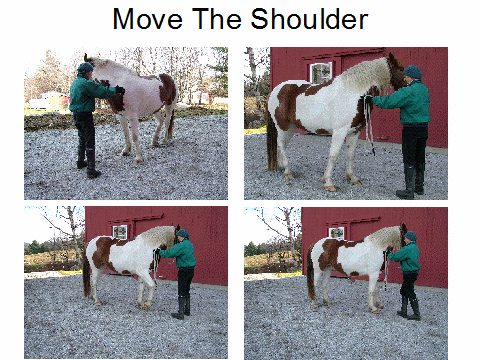
DRIVING FROM THE GROUND UP
DRIVING AS A PARTNERSHIP BETWEEN HORSE AND DRIVER
Following are some aspects to consider for achieving a mutually safe and enjoyable driving experience. There are many more, but I put much emphasis on these when teaching a horse to drive. Please also keep in mind that there are many different ways to approach this subject. What works for me may not work for others.
Driving is a much more dangerous interaction with horses for us humans than is sitting on a horse's back.
Attached to a carriage, a horse in panic can do much more harm to himself and others than while under saddle. He is way out in front on his own, the driver has fewer means of control and a carriage can easily hit an obstacle or fall into a ditch without much deviation from the intended path.So needless to say, a driving horse carries a lot more responsibility than a riding horse and needs to be better educated.
Driving has become very popular today, especially with people with no or little prior horse experience. Be it that they have an outgrown child's pony they would like to do something with, or they feel they would be rather sitting in a carriage instead of on a horse's back, or it just looks like a fun thing to do.So is there a way to make this endeavor safer and truly enjoyable?
From my own experience, I believe there is: it is to build a mutual partnership based on trust and respect for each other.
What exactly is a partnership? According to the dictionary it is:
|
A relationship between individuals or groups that is characterized by mutual cooperation and responsibility, as for the achievement of a specified goal. |
|
So what is a relationship? a state of connectedness between people (especially an emotional connection)
|
And what is trust?
Again, I would like to quote the dictionary: Firm reliance on the integrity, ability and character of a person or thing.
And respect?
To consider worthy of high regard
The state of being regarded with honor and esteem
Willingness to show consideration and appreciation
So, to sum it all up, we need to create an emotional connectedness with our horse, a mutual cooperation where each part has to fulfill responsibilities, where each can consider the other worthy of high regard and where each can rely firmly on the integrity, ability and character of the other.
This may even seem a difficult task to achieve between people, but between horse and human? How can one reason with a horse, how can one make clear to him what is expected, how can one possibly meet one another in the middle? Is it at all possible?
It is very much possible, but the greater part of the job and responsibilities will have to be carried by the driver. Horses have all the required innate ingredients, but it is the human's job to help the horse apply them for the intended goal.
It also requires from the human to educate the horse rather than just training him. By this I mean not to teach the horse physical skills only, which is mostly done by a punishment and reward system, but to regard the horse as an intelligent and emotionally vulnerable being , and to responsibly educate his mind so he can use his body confidently and with full mental agreement and understanding of the requirement.
For this reason, I will not use the word trainer in the following, but rather the word teacher.
RESPONSIBILITIES OF THE DRIVER
Understanding of the Horse
1. the nature of the horse,
The horse is NOT a human, although he possesses nearly all emotions and feelings that we humans do.
The horse has his very own genetic coding, his very own needs as a species.
The horse is a prey animal, the human a predator. This fact alone creates very different view points of given situations. His fears may seem stupid to us, but evolution over millions of years deemed them necessary for survival of the species. Horses have a remarkable memory, especially for things that caused them harm or frightened them severely, and they also have an uncanny photographic memory. Any little change in the environment is noticed. The horse also perceives things with one eye at a time, so in order to truly familiarize himself with an object he needs to see it from both sides of his body. Very unlike humans.
2. physiological makeup as a species,
The horse is a very social herd animal where lasting friendships develop.
He has very different nutritional needs, he practically has to eat around the clock to keep his digestive system healthy, and he needs lots of exercise and much more clean air than a human to keep his body healthy. He does not have a day and night rhythm like we humans do, horses sleep relatively little, and only short periods at a time. Horses prefer wide open spaces and exposure to the elements, very unlike humans.
Considering our typical and traditional horse keeping in solitary stalls with regulated feeding times, it is easy to see that a lot can be done to improve at this level.
3. the individual makeup of the horse at hand
Just like no two humans are ever alike, no two horses are either. In every regard. Physically and emotionally. What one horse can tolerate easily another one cannot endure without becoming unsound, sick, nervous, dangerous, depressed etc.
4. soundness
This can often be very difficult, as many soundness problems are very hard to see or figure out.
Often it takes very skilled specialists to diagnose a seeming resistance, a strange habit or outright lameness. The equine field has grown incredibly in this regard, with alternative therapies and diagnostics steadily on the rise. Including, but not limited to chiropractic, massage, acupuncture, energy therapy, and the increasing number of animal communicators.
5. current state of knowledge
When outlining a training program for the horse, the current state of knowledge and understanding needs to be carefully evaluated and adjusted to. All teaching has to happen in logically consecutive steps, and one has to make sure all are in the right place
6. mental and physical ability
Each horse has certain mental and physical strengths and weaknesses. We need to understand what they are and how to correspond to them when working with the horse.
7. the age of the horse
While humans are very quick to excuse personal shortcomings with young age, old age, immaturity (both physical and emotional) hardly any allowances are given to the horse. Routinely 2 y old horses are expected to be physically strong enough to carry a rider or pull a vehicle, and mentally and emotionally mature enough to deal with the demands.
Male horses do not mature until they are at least 6(physically) and 8(emotionally) Mares may mature a little earlier. While the growth plates on the legs mature fairly early, between 2 and 3, one of the most vulnerable physical parts of the horse, the hocks, only mature at age 4 and the vertebrae incl. pelvis at age 5 to 6. In riding, as well as in driving, these are the parts that get lots of stress. In some ways, pulling is even harder on the hocks and pelvis than is carrying a rider. I would like to refer you to the website of Dr. Deb Bennet http://www.equinestudies.org/ for more information on this subject.
One proof for how much physical over demand is being placed onto our horses can be found in the abundance of equine supplements on the market, and of course drugs as well. Champion horses are used to advertise drugs and supplements for nearly every imaginable joint, muscle and tendon issues, and plenty of remedies are offered for emotional problems. Most of these ailments occur because the equine body and mind are over challenged at too young an age.
Please read also the following link www.equine-reproduction.com/articles/Horse-Lovers.shtml
Character
I would like to include here love, compassion, kindness, patience, support and humility.
Love and compassion for this so very different creature, for who and what he is, for his strength and weaknesses
Kindness in all we ask, in all our actions directed toward this being
Patience for the attempts of communicating with us, for trying to accommodate us, for the physical and mental evolving
To help and support with all our means this willing and gentle animal in its efforts to adjust to our demands
Humility toward a creature, so much more evolved and deemed perfect by nature than we are, their immense willingness, patience, and tolerance for our human shortcomings
Ability
The teacher needs some basic theoretical and practical skills, and also will need some physical and athletic ability to keep up with the horse.
If he has no idea of what exactly he wants from the horse or can ask from the horse in a given moment, is unable to communicate his intentions, is not knowledgeable enough to further the horse's education, cannot read the horse's response to a request, is too clumsy or too slow when applying aids etc. etc., the horse will not be able to believe in such a person. Many horses have very little tolerance for ineptitude and incompetence from their handler. They will quickly try to take over or at least totally ignore the human and treat him as if he was air. More tolerant animals will at least become confused and frustrated.
Of course, we all make mistakes, and horses seem to be able to deal with many of them in admirable ways. Horses also have a very innate sense of fairness and an understanding of the intent behind a human action. They are very astute mind readers. I have seen many horses who take unbelievably good care of a very trusting and innocent handler, making all kinds of mistakes, but turn very defiant and violent when an “accomplished” handler violates either the horse's basic nature or current understanding and ability.(But they also may act this way because they are being put back into second place, even when it is done in a fair way)
Trust
By this I mean that the trainer needs to be worthy of the horse's trust.
How do we gain trust?
By asking something that is within the horse's reach, by not annoying him with endless repetitions, and by being firm, kind and absolutely consistent with our signals, and by lavishly praising him for the right response.
By not exposing him to situations that he cannot handle and may even result in pain or injury, by always proving to the horse that all is well and safe.
By considering him as an intelligent and feeling being, not some dumb and inferior creature.
I would also add familiarity. It takes quite a while to build trust, even under the best of circumstances. With most horses, it will take years of being with the same person, even if this person is competent. It will be very difficult for a horse to develop any kind of trust if he is handled by different people who apply different methods. Horses may also implicitly trust one person, but will not be able to trust anyone else. Buying a driving horse from a person who had a great relationship with a given horse does not automatically mean that he will be the same horse for the new owner. He may act totally unpredictably and even be dangerous.
RESPONSIBILITIES OF THE HORSE
Understanding the Human
Although it is we humans who want something from the horse, horses also need to take on responsibilities.
They will need to learn to understand our body language and even our vocal language.
They will need to learn, amongst other things:
standing or moving at a certain pace when asked to do so,
moving their body in a certain way,
listening to physical or voice commands from the handler,
controlling their fears,
controlling their emotions,
understanding that when hitched to a cart they cannot do the same things as when they are loose in the field
look to us for guidance in difficult situations, not making their own decisions
submit to our requests at all times
and so on
But of course it is up to us humans to make all this important to the horse, and without understanding basic nature of horses it won't work.
Ability
As the party who wants something from the other, we also have to be a very good judge of the horse's ability, be it the innate one or the acquired one through training. If we are a good handler, we soon can figure out what the horse can do or not, what he understands or not, and when we ask within these limits, with kindness and patience, we can trust to receive the right responses from the horse, every time we ask.
But again, all this depends on our ability to assess and access the horse's ability.
Character
Horses really don't have a moral or ethical code in our human sense, but they are very true and honest in always letting us know how they feel about something, and where we stand in the hierarchy.
A horse unspoiled by man is who he is: straight forward in his emotions and intentions, inquisitive, without malice, willing to submit to someone clearly superior. Although horses pretty much possess the same range of emotions as we humans do, like love, hate, anger, frustration, ect., and each horse has a very unique and distinct personality, with all the human traits of being timid, bold, willful, strong willed, meek, patient, impetuous, agreeable, cantankerous etc. etc. they make no secret of them and display them for everybody to see who can read them.
They also have an innate sense of right and wrong, but they do need to always know where they stand with us, and they will keep testing the borders, as they have this need for security and leadership. Horses have survived all these millions of years because they keep questioning their position within the herd, as any weakness of the current leader may lead to disaster for the herd.
If we humans don't violate a horse's nature by afflicting emotional and physical discomfort or pain and learn to read their answers to us, we have a most forthright personality to deal with. Only horses who have had to defend themselves repeatedly from ignorant or cruel humans, lack this integrity, they are wary and they can be very calculating and defensive, sometimes to the point of aggression and violence. But with the right handler, even this can be put right again.
With enough knowledge and sensitivity we can preserve all the positive features in a horse, and make them work to our advantage
There is no bad horse, no stupid horse, no malicious horse, not until we make them that way, not until we force them into this role that they would not want to choose for themselves
Trust
In order to be comfortable with a horse, the driver needs to be able to trust the horse.
Horses have to learn to react to the driver and their surroundings in ways that are safe and predictable.
Depending on the individual personality and emotional ability of the horse, this can be a fairly easy job for the horse, or very difficult. Some horses are so timid by nature, or have had such bad experiences, that they will not be able to always control their fears and negative expectations. It may be so bad that they cannot be trusted enough to make a safe driving horse.
But a lot has to do with way the driver teaches and handles the horse, and familiarity certainly plays a huge role.
OUR ROLE AS THE LEADER
The list of requirements on us as the horses' superiors and handlers seems to take on immense proportions, and it becomes quite clear that one cannot master all of this in a short time and expect it to be sufficient to start a fruitful and safe relationship with a horse. The sad part about it is: if we are not competent enough, it is most always the horse that pays, for even if we get hurt ourselves, it will still be worse for the horse. He either will be stamped unreliable, crazy, stupid, malicious and will be sold or passed on, or left to his own devices in someone's back yard, sometimes cared for and sometimes not. Unless he is lucky enough to find a different person who can understand him and help him out of his predicament.
So let us explore how we can become a trusted and accomplished leader to spare our horse any harmful consequences.
What makes a good leader?
Mark Rashid made an interesting observation. From watching many horses in herd situations, he found that horses choose what he calls a "passive leader". This is usually not the boss horse, as most boss horses are just too bossy, and the underlings are afraid of them. What he means by passive is simply the fact, that these horses are very sure of themselves, can assess situations very quickly to their benefit, know how to stay out of the boss's way and not aggravate him/her, radiate confidence and harmony, don't seem to need to suppress anybody, like to be social, but also do not accept insults from herd members. Thus they appeal to others to hang out with them, wanting to be with them.
He feels that we humans should live up to being this passive leader rather than the boss.
Someone else, I cannot remember who, came up with the term :benevolent leader
I think I like that even better, as it implies that we want the very best for our charge and always think of the horse first when assuming the leader role.
So, all this said, how does one go about to get this kind of relationship?
Earlier, I mentioned the theoretical side of it, the necessary physical and emotional ingredients. Now I will try to explain the practical application.
HOW TO BECOME AN ACCEPTABLE LEADER
Within the last 20 years many compassionate trainers have developed ways to gain a horse's respect and trust through methods that are easily understandable to the animals and do not violate their emotional and physical abilities.
Some of them are Natural Horsemanship, clicker training, the Tteam approach, and many others.
Pick a training method and stick with it
All of these methods lead to very satisfactory results, but for the average horse owner, with not too much time to spend, it can all become somewhat confusing to sift through all this information. And the more confused the owner, the worse off the horse is.
Some horses are so turned off by all this "new" stuff as their owners go to so many different clinics, trying so many different approaches, that nothing makes sense any more.
What works for me
In the following, I will try to tell you what I have found to work for me and the horses I work with, after watching many different methods. I use only very basic and rudimentary signals, don't need a round pen, don't claim to follow one method or the other, although you may recognize some of it coming from this or that trainer, and the results are quite fast and rewarding.
Required tools
The only tools required are a halter and a lead of about 12 feet,
Required work area
Some of the work can be done in the barn, or even in a large stall, if necessary.
For the rest one needs a work area of about 30 to 40 feet, a driveway or even a back road. It does not have to be perfectly level, but should afford good traction.
The one requirement is that it is an area with few or no distractions, at least at the very beginning of training.
The horse needs to be able to focus on the teacher.
Some good reasons for the horse not being attentive or receptive would be if his closest buddy is being taken away, if he is very new to distractive surroundings, if his basic horse needs of sufficient exercise and time to play are not met, if he is overfed with concentrates that make him overly stimulated, or if he is very uncomfortable or even painful in his body.
No horse can truly learn anything beneficial unless he is in a calm state of mind and comfortable, just like us.
When outlining my teaching procedures in the following I assume that this basic requirement is met.
Of course, there will be situations with certain horses where this is not a given, but unfortunately I cannot go into all this here. It would make a book. But if you need help, there are plenty good teachers available now, lots of books and DVDs, and lots of good articles on the web. If you still have a problem, you are welcome to contact me.
The Building of Respect and Trust
So basically, what does one have to do to gain respect from a horse?
One asks him to do certain movements with his body, that make sense to him and signal to him: I (the handler) am the leader and I ask you to move out of my way, go ahead of me, back away from me, stand still so I can touch you etc. This is how horses communicate with each other, this is how they determine rank within the herd.
How do we gain trust?
By always being predictable to the horse. By asking for the same things in the same way.
By asking for things that are within the horse's reach, by being kind, but firm and absolutely consistent with our signals, by not annoying him with endless repetitions,and by lavishly praising him for the right response.
By proving to him that what we ask works and no harm will come to him listening to us.
By making sure that the horse truly understands what we want and that he will succeed executing it.
By always considering the horse's point of view.
By always striving to use the lightest aids possible and instantly rewarding any attempt to do things right by discontinuing the aid, but also to be persistent when the response is slow and hesitant.
Use of voice
I prefer talking quite a bit to my horses, not confusing wishy-washy, but things like good boy, great job, very brave etc. When working on stops, backing, gait transitions I always use the command that I will later use in driving, and I am very careful that all commands are distinctly different from each other so the horse will not confuse them. I even chose horses' names so they don't sound like a command.
For example, the name Mack would very much sound like the command back, and the name Beau like the all important Whoa. So if your horse has a name that he listens to already, then you have to choose a different sounding word for a command. It really does not matter to the horse what you say as long as you and he know what it means and it is applied consistently.
I also would like to mention here that horses are very visual animals, much of their interspecies interaction
and communication takes place by observing and displaying body gestures.
When wearing blinders a horse cannot see the driver, so having a relationship based on trust and a communication based on mutual understanding, esp. regarding the application of aids, be it whip, voice or reins, becomes that much more important.
So how will all this work help us in driving?
First of all, we will have been building a relationship with the horse. We will be able to communicate, know what to expect from each other, we have become familiar with each other. We can read and understand each other.
But we also can now with precision and relaxation place the horse's body where we need it to be. Be it while grooming, harnessing or hitching. We don't have to tie our horse for grooming and harnessing, when he moves out of position we can calmly put him back where we want him to be without shoving and making him nervous or resistant. When hitching him to the cart we can with precision put his body into the required position, and when he moves without being asked can put him quietly and calmly back to where we need him to be. No more holding the head while hitching, no more nervous horse anxious to move off. The horse will be in agreement with the request and execute it with confidence and willingness.
20 BASIC EXERCISES FOR BUILDING RESPECT AND TRUST
I will not give a detailed explanation of all exercises, esp. for a horse who is very disrespectful of his handler or very nervous.
I merely give you an overview of what I feel is important, with a brief explanation.
As I said before, there are plenty of good sources available if you feel you are not sure of how to apply the following. And if anything remains unclear, I am glad to help.
And also please keep in mind that what I am talking about today is what works for me. There are many different ways of getting to the same goal, and it does not make one method right and the other wrong.
One thing I still have to mention:
Whenever we ask the horse to do something, we do this first with the lightest possible aid, then, if the horse does not listen, gradually increase the pressure. We want the horse to become very light and responsive to our requests, so we need to train him to as light an aid as possible.
I allow about 2 to 3 seconds for each incremental increase.for a total of about 4 to 5 increments, but you can use as many as you like.
Eventually it will not even be necessary to touch the horse as long as he can see us. Just looking at the body part we want him to move or pointing at it will be enough. But keep in mind that horses wearing blinders cannot see this, so in this case we will have to use physical contact, and they need to be taught to understand this.
The first 10 exercises can easily be done in a small space like a stall or grooming area.
1 move the shoulder
in this exercise we ask the horse to move one shoulder sideways one step at a time.
The crossing leg should pass in front of the stationary leg
We gently push his head into the direction where we want him to move and at the same time apply
light pressure to his shoulder with one or two fingers. If he does not respond to light pressure, we
increase the pressure in increments until he shows the slightest attempt. Even if he does not cross over
yet and does not really move sideways yet we reward the attempt by relieving all pressure
immediately and then repeating the exercise.
As soon as the horse has responded we praise him by scratching, stroking or rubbing him and telling
him what a good horse he is. Before we repeat the exercise we first rub him a bit all over his neck, then
down to his shoulder, so we don't surprise him with our aid.
At first we only ask for one step, take a break, then another step, change from one side to the other..
When he is good at it we can ask for more steps in a row, but always one step at a time. We don't
want him to learn to rush anything and only do as much as requested.
This exercise is also the basis for a turn on the haunches, and the turn we need to have the horse
pivoting the carriage around the inside wheel(s).

2 move the hip
For this exercise the horse has to look toward you and the side you are trying to move sideways.
In other words, if you want to move the horse's left hip, you will stand on his left side and make him
bend his neck and head a bit to the left. When teaching this exercise to a horse that is mainly ridden
I tend to use my pushing aid where my leg would be. For the driving horse I push further back, like
the flank area or even the hip area. It should be at a spot that you can reach with your whip from the
carriage, then it will make more sense to him.
The same basic ideas apply as above. The crossing leg should move in front of the stationary one
and we ask only for one step at a time. Praise every attempt or successful step, and before repeating
the exercise rub your way along the horse toward the pressure point again.
This exercise is also the basis for the turn on the forehand. For the riding horse, this turn has many
applications, for the driving horse we only need this understanding to move the haunches to the side
as when asking for a better bend in turns, for moving the rear end one way or the other when on a
straight line, for maneuvering the horse between the shafts or when hitching a pair horse to the carriage.

3 come to me
for this exercise you move to the end of the rope in front of your horse and ask him to come to you
by applying first the lightest possible pressure, then increase until he listens.
When he is close enough, say Whoa, and raise up one or both hands as a stopping signal. Then
praise again.
This will help to make him lead eventually on a light contact.
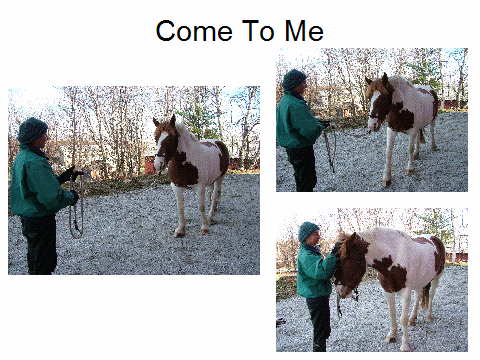
4 back up
For this exercise the horse needs to be really relaxed, with his head about at wither height, and the
poll soft. Then gradually start applying pressure backward on the nose band until he thinks about
backing up or actually does back a step. Instantly release pressure and praise. When the horse has
a problem with this or crowds you you can also push on his nose with your free hand.
One can also push against the chest, but since driving horses have to learn to move against pressure
there it can be a bit confusing for them. Although they can and will learn to understand the difference
over time.
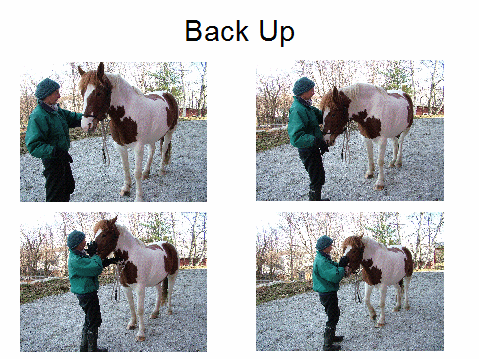
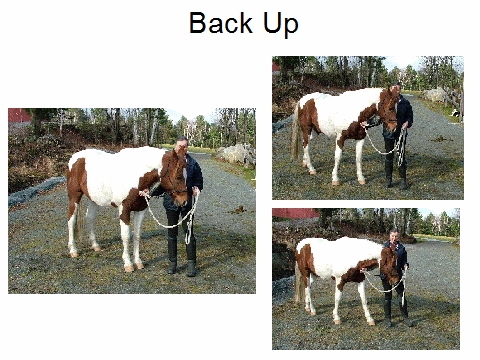
5 head down
This is a very important exercise for a driving horse, and you should make sure that he does this really
well. Not only does it make it a lot easier to put the bridle on, but should the horse become stuck with
his bit or a rein around a shaft he will not panic,
and when you need to hold him in a dangerous situation on the head he will know how to respond
properly. Needless to say it is also useful should the horse step on his lead rope or get tangled up
some other way with his head, or is tied and gets scared and tries to pull back.
To teach him to respond to pressure, start applying pressure downward with the lead rope.
This sometimes takes some patience and strength. Many horses will respond to that first by raising
their head. Again, every slightest attempt needs to be rewarded.
Eventually you should be able to just press lightly with your hand on the top of the poll, or pull ever
so lightly down on the lead, and he should keep his head in any desired position, for as long as you
are asking him. This also helps a lot with ear shy horses.
This exercise also will help to make him lead on very light contact.
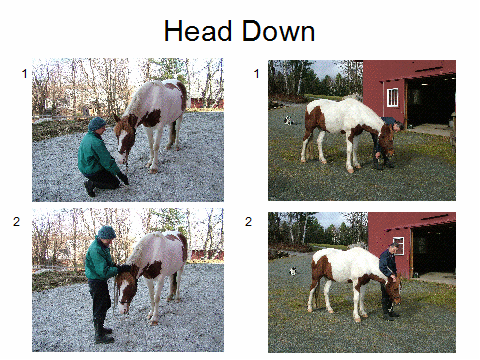
6 flex neck to each side
Although this exercise is more important for a riding horse as one can use it to get a horse to stop
under saddle, it still is a good thing to teach to the driving horse. It helps to enforce the request of yielding
to pressure, supples his neck and helps detect stiffness problems.
You start this by first turning his head to your side by bracing your free hand against his neck and
with your other hand on the halter ask him to look your way.
When he does this, move your free hand further toward the shoulder and repeat. Most horses will
at first circle around you, until they understand the request.
You can also take the tail into your free hand, bring it forward and let the horse sniff on it.
This helps to control the rear end a bit better, but usually also results in a lot of circling at first.
As another variation you can turn the horse's head away from you by bringing the lead over
his back and apply pressure to the rope until his nose touches his side opposite of you.
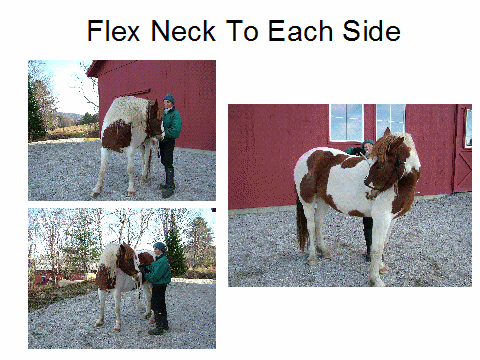
7 turn all the way around, following the lead
From this last position, you can run the lead around his hind quarters and make him turn around all
the way. Another way of yielding to pressure

8 pick up all feet from the same side
this is very valuable for the driving horse, especially in the pair, as when a horse is hitched and
you need to check his feet for whatever reason you need to do it from the same side, or with a single
horse, you don't need to run around to the other side
and it is just another thing to do with your horse to establish communication

9 rope around the legs
you want to get your horse used to being touched around and between the legs just in case he gets
tangled up in traces or other parts of the harness, should something brake
It also is very helpful to put the rope around the ankles and lift the leg this way, moving it in all

directions.
This gets the horse used to not panicking, should his legs get
tangled up in something
10 rope under tail
this is of course a good practice for accepting the crupper, but also a good preventative for ground
driving, should the long rein or rein get caught under the tail

All the above exercises are very elemental and simple, and it does not take long at all for the horse to learn them, but their far reaching effect on your relationship with the horse is enormous. It is a true pleasure to handle a horse that understands those basics, and it gives the horse great peace of mind by understanding what he is supposed to do.
As mentioned earlier, horses like to interact, and like us humans, are very willing to “play games” that lead to reward and appreciation. Who does not like doing things that work out well, get approval and praise.
11 standing untied
One can do this of course in a stall as well, but it becomes more meaningful in an open area.
We tell the horse to Whoa, and when he moves we just move him back quietly to where he was.
Since we can easily do this now, it is not a big deal, we get to practice all the previously mentioned
maneuvers, and the horse will soon find out that he does not have to do any work if he complies
and stands still.
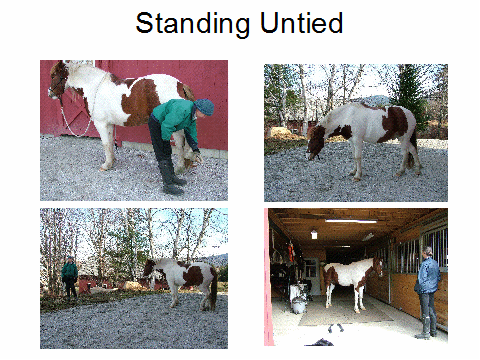
12 sending the horse out onto a circle
Let's say you want to move your horse off to the left.
You stand near his left shoulder, your left hand holds the lead about 1 ½ to 2 feet away from the
halter, plus the surplus length. Your right hand holds the other end of the rope, with about 1 foot left
hanging. This end can be twirled toward the horse or also be used to touch the horse if the twirling is
not enough. It is our driving aid.
With the left first finger pointing, you raise the lead ahead of the horse to show him where you want
him to go, and with the right you twirl a little the end of the rope. Just like before, increase this aid
in increments until he listens. You also look where you want him to go. This is very important.
If you keep looking at the horse he may not move.
As soon as he responds by moving off you drop the lead out of your left hand and give him full freedom
to move. Then you pick up the lead again with the left hand close to your right hand.
The goal at this point is that he walks calmly around you 2 or 3 times. You keep encouraging him
with the driving end of the lead, and if he comes in toward you you step quickly toward him waving
the entire lead at him.

13 bring back in
Then we bring him in by disengaging his hind quarters. To achieve this we slide the left hand up on the
lead, crouch down with our posture, stare at his hind quarters, point with the right hand there as well,
control his forward movement with the left hand. If all this is not enough we can move closer to him
and touch his hind end with the end of the lead. Most likely this will not be necessary.
He will step over for 2 or 3 steps and come to a halt.
Praise lavishly and try again, alternating the directions.
This work on the lead is a wonderful exercise to teach the horse voice commands and basic longing skills.
This does not require much space, no round pen, and the ground does not have to be totally level.

14 change direction
One can change the direction without actually bringing the horse to a stop.
For this one disengages the hind quarter like when bringing the horse in, but as soon as he complies
one points with the new leading hand into the new direction while using the other hand now to drive the
horse on. The horse will turn toward us, but following the new direction signal it will cross over with
his front leg away from us like in the turn on the haunches.
This is a very efficient way of changing direction and requires lots of coordination from both, horse and
handler. The trainer needs to be very quick changing the leading and driving aid from one hand to the
other, the timing has to be just right, and the horse needs to really pay attention and respond
willingly and quickly. It is really fun to do once horse and handler get it right.
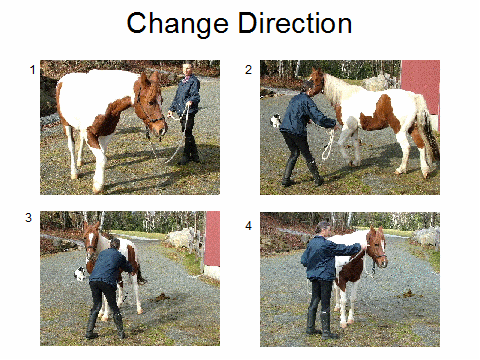
15 introduce trot and transitions
When he does all this well at the walk we can start with the trot. Since the circle is very small, only
a calm jog trot should be expected. One can make the circle larger by moving with the horse,
especially if he is too excited at first for a calm trot. When he does well on the shorter lead, one can
also use a longer lead or longe line.
Then one can also do lots of transitions, like walk/trot, walk/halt, halt/walk, halt/trot etc. etc.
One can also ask for rein back by voice. This usually needs quite a bit of close up help at first,
but eventually one can rein the horse obediently back at the end of the line.
This can be very helpful in many instances: when grooming, harnessing, hitching, when he got
himself into a tight spot somewhere in the isle, backing out of a trailer etc.
16 leading at walk and trot, asking for transitions with voice commands,
practicing standing and backing, all from both sides of the horse
By now, the horse should follow you around on a loose lead, at the most with some light contact.
If he gets “stuck”, esp. in the transition to the trot, you can point with your leading hand and drive
with the end of the lead like you did on the circle.
His head should be either at your shoulder or just a tad behind you.
Practice a lot of turns, both ways, to the side you are leading from and to the opposite side. This you
do by pointing with the leading hand in front of him, and if necessary, push him a little on the shoulder
like in the turn on the haunches.
You can lead him behind your back from one side to the other by switching the lead from one hand
to the other.

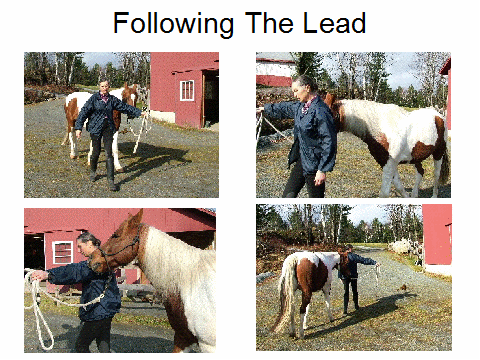
17 send the horse ahead
Now is the time to teach the horse to move ahead of the handler. This is great preparation for
ground driving. Basically it is the same as the last exercise, but the handler now stays at shoulder
height of the horse or even further back, and the horse has to take on the leading role, but still
be in full control on very light contact. The aids are the same, the pointing leading hand and the
driving and supporting hand. At first the horse may circle, cut across the handler's path, go strong
against the lead etc. But he soon will learn.
From this exercise you can bring him easily back to your shoulder, change direction behind your back
and push him ahead of you from the other side.
You now have countless combinations you can ask from your horse and make a walk very
interesting and challenging. E.g., you can change from leading him to a circle, out of the circle
to moving ahead of you, from there back onto a circle, change direction within the circle, trot off
into a straight line, make tight turns both ways, come to a stop, etc. etc.
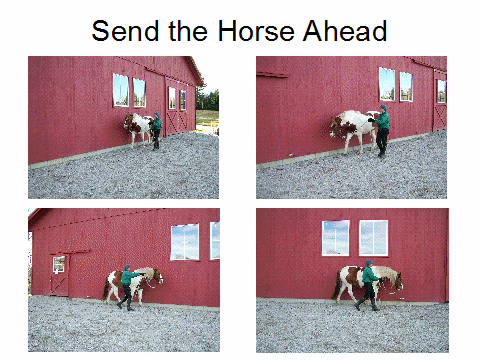
18 side passing
side passing is just another coordination exercise. Although a driving horse never actually can
perform side passing as such, he still needs to do a lot of side stepping in turns. This exercise
will help him with the understanding and body coordination he will need for tight turns.
It really is a combination of move the shoulder and move the hip.
Except, that now the horse is always looking opposite to where he is going.
In the shoulder move exercise we pointed his head toward where he is supposed to move to, in the
hip exercise in the opposite direction.
For this exercise his body should stay straight, only his head and neck are slightly looking toward
the side he is yielding away from. His shoulder needs to lead, his body should never be more than
45 degrees to the line of movement. If the angle gets more than this he will step onto his own feet.
Usually it is enough to lead the head a little and point the end of the lead toward his flank.
It does take coordination from both parties, but really is surprisingly easy to do.
The reason we have the horse look toward us is that it is easier for him and us like this.
Later, in the carriage, he will look into the direction he is going like in a turn on the haunches.
If you are coordinated enough you can teach it to him like this to begin with, but horses seem
to have no problem with doing it both ways.
The easiest way to start is a few feet away from and along a fence or building, but once the horse
understands, you can do it anywhere.

19 work over poles or boards
Now we can introduce poles or boards. I like boards better as they don't roll, the horse can step
on them without hurting himself, and they are easier to carry around.
We can ask him to step over and back over single boards, a combination of boards, back straight between
boards, back around corners, and we can also side pass him over boards
This work is very important for a driving horse so he learns to trust stepping over things,
touching things with his feet, staying within certain limits of an obstacle etc.
If this kind of work is omitted he may easily panic in the carriage when he has blinders on, should
he get into a situation in the woods or in a obstacle class at a show

20 working horse over all kinds of different obstacles
Now we can give free rein to our imagination. Puddles, streams, tarps, black and clear plastic,
ply wood, teeter totter, soda cans, plastic jugs, tires and what ever else you can think of.
You can lead your horse or send him over or into things, push things between his legs like paper
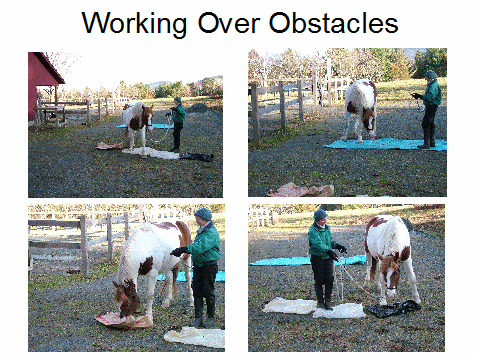
bags, soda
cans and plastic jugs.
The more you get him used to the better. Just keep it all a fun game.
As I said earlier, these are all very basic exercises, and you can teach your horse a whole lot more on the ground, but if you don't have much time to spare, these will do fine for most horses. Some horses are very timid or strong willed, and they may need additional time and consideration.
But for the majority of the horses this is a great and sufficient base for beginning with ground driving and the actual driving ecucation.
INTRODUCING THE WHIP
Just one more thing we have to do before starting the actual driving process: the horse needs to understand and accept the whip as an aid. He should never fear it. Respect yes, but not fear.
This we accomplish by rubbing the horse all over his body with the whip, between the legs, up and down the legs, behind the ears, etc.

One can also swing the whip through the air around the horse, hit the ground with it, make some noise with it, at first very gently, then increase the motion and noise. I also like hitting a wall or other objects with the whip.
Then we teach him to listen to the various touches.
There are two basic things we want to tell the horse with the whip: move forward and move sideways
The difference is where we touch the horse with the whip
Introducing the lateral aid
I like to begin this with moving the hind quarter. This is basically the same exercise as moving the hip, but now I tap the horse lightly with the whip in a spot that I can easily reach from the carriage. The same basic principles apply as before, start with the lightest aid possible, and instantly stop as soon as the horse complies, and always one step at a time.
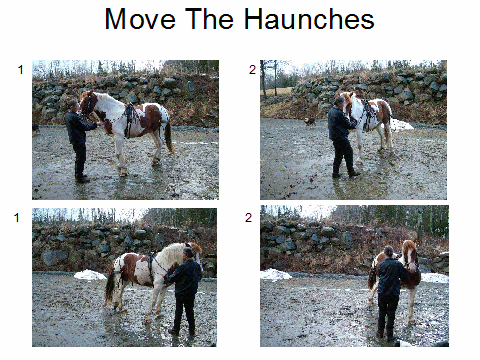
Then I do the shoulder move. Usually I introduce this during the ground driving process, using the halter. For this, I stand behind the horse, turn his head with the reins a bit in the direction I want him to move to and tap him on the opposite shoulder. He may first move forward or back up, but will soon understand, esp. if you explained the shoulder move to him well in the beginning.
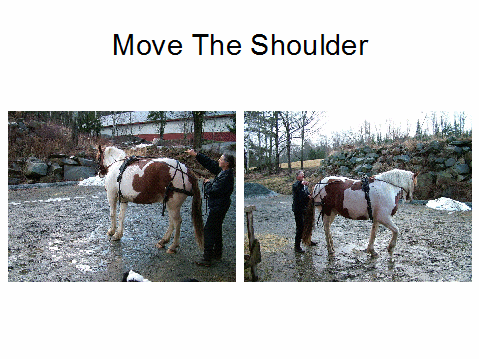
After doing this both ways, I ask for side passing. A few steps are enough.
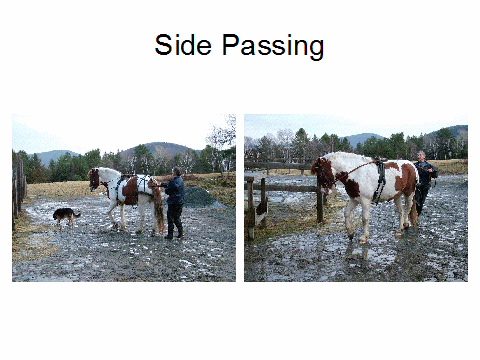
The whip as a forward aid
To signal forward movement it is best to touch a driving horse high up on the back, right behind the saddle, on either side of the back strap.
One can also get the horse used to it by tapping him on top of the croup, but this may lead to bucking. But you can practice it anyway, just so he won't buck if you accidentally hit him there.
Personally, I train my horses to accept this spot as sort of an emergency spot like: you need to move forward NOW and no questions asked. This location of touch offers itself more to really get a horse to move as it directly affects his hind quarters and thus the engine. (when horses among themselves want to really move another horse out of the way, and this horse does not listen to gestures, they usually bite him on the croup)
Touching the back requires more mental agreement from the horse. It is at or even in front of the so called “driving line” of the horse, the invisible line in a horses body where a cue signals either forward or backward movement to him. In other words, when you want to push a horse from the ground, facing his side, you need to address the right part of his body. When you apply your aid and intention too far forward he will not move or even back up. This line is usually close to where the rider's leg would be, but each horse may have a little different spot, often depending on state of mind. So when you touch a horse close to this line, he may interpret it at times according to his mental state. If he feels willing and bold to go forward, he may do this, but if he feels timid and rather not go there, he may not respect it as a forward aid.
TEACHING ABOUT THE BIT
As this is the most important aid in driving, I will spend some time now sharing my thoughts and experiences regarding the application of the bit.
The very first step is ground driving.
GROUND DRIVING
By now the horse has learned all the ingredients for successful ground driving. There are two stages to this, ground driving using the halter and ground driving using the bit.
At this point I also would like to mention that I teach everything first without blinders, and when the horse has gained confidence and understands the concepts, I repeat everything with blinders.
What is the horse supposed to learn at each stage?
Using the halter
In this stage the horse is supposed to learn the ability to walk ahead of the trainer, learn the basics of steering and the basic balance of moving on straight lines and around turns. He also learns about voice and whip commands.
As a horse at this stage is quite wobbly, won't be able to keep a steady rhythm, may be quite timid about being sent ahead, it would be unwise to start him on a bit. One has to correct too many of his actions, and this would only hurt his mouth.
He can carry the bit in his mouth to get used to the feel, but the reins should not be attached to it.
I like using a side pull bridle for this, it gives more control than a halter and has rings sown on on each side of the face to attach reins to.

The only other equipment is a surcingle with large rings on the side and higher up, where normally the rein rings are located on a driving saddle, or a driving saddle and long lines or driving reins.
For better control of the hind quarters, the reins are at first run through the rings on the side or the tugs on the saddle. When the horse steers reliably and walks well forward on straight lines, does his transitions well and walks over scary objects without hesitation, the reins can then be run through the top rings. This is very important as we want him to learn steering like he will feel it later on from the carriage, and we don't want to teach him to be laterally confined by rein contact. Although necessary at first for the very basic controls, running reins through the side rings or shaft tugs should only be a short transition period.
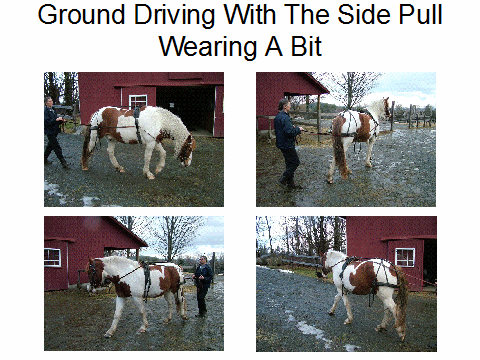
During the halter stage, you can ask many different things from the horse like performing transitions, negotiating turns, stepping over and through obstacles, conquering scary sights, taking him on long walks on trails or quiet roads, and the introduction of the whip. The more you get him used to, the more you can teach him at this stage, the easier it will be for him once he is controlled by the bit.
Using the bit
In this phase of his training the horse needs to be made familiar with all the basic commands the bit is supposed to convey, and needs to learn to willingly accept the bit and trust it.
Most of the work will be done at the walk, as it is difficult to keep up with a horse at the trot, but if you are athletic enough you can certainly do some trot work, and especially work on transitions. Just be sure not to balance yourself on the reins or restrict the freedom of the horse's neck.
More detailed trot work will have to be done from the carriage.
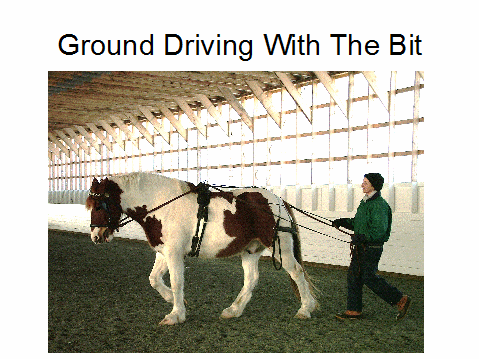
Bit commands
So what precisely is the bit supposed to tell him?
Obviously, we use the bit to control forward motion and to steer the horse, like we did when ground driving on the halter. It is the principle of yielding to pressure again.
Not so obvious, the horse should accept the bit as a safe haven, as his trusted place to go at all times, in other words a constant goal toward which he can work in confidence and relaxation. We should not give him any reason to dread the bit, to fight it or to hide behind it.
I like Dr. Deb Bennett's phrase: Being on the bit is not something that the bit does to the horse, but that the horse does to the bit.
I also like her statement that a horse only likes to be where he feels 100% OK, and that he only can learn when he feels that way. If a horse is not comfortable, all he can think of is that he would like to be where he could be comfortable, where ever that is: with his buddies, in the barn, back home etc. etc. Really just like us.
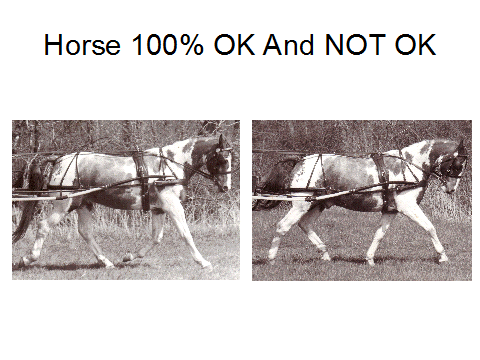
Backward function of the bit
It is common knowledge that bit action has backward function, by the very fact that it is at the very front of the horse and that its activation is either unpleasant or restricting to the horse, or both, if not used properly.
One might ask, is it really restricting? Horses keep running or even taking off when lots of bit pressure is applied, so it can't be all that restricting, right?
What restriction means here is that it impedes free and relaxed forward movement, it stiffens joints in the horse's body and does not allow him to move unrestrictedly, a state where all joints have free range of motion.
What it mostly restricts directly is the poll and neck, as the neck is highly mobile, and this in turn restricts the entire horse.
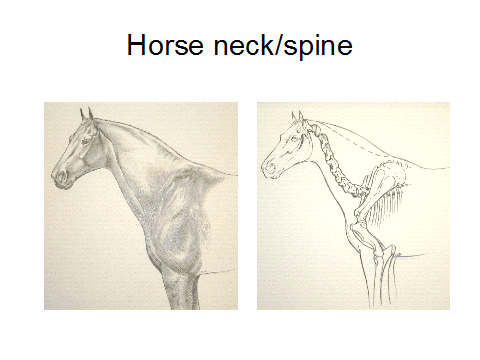
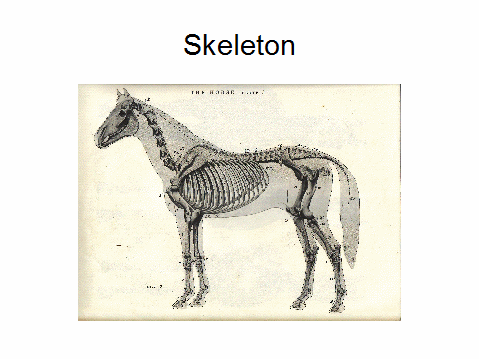
Why is this so bad?
Because it makes the horse uncomfortable, makes him physically and mentally tense, makes his body crooked and his energy difficult to contain, and causes bodily injury over time.
Needless to say, it also makes the horse a very unsafe partner to be with. How would we like to spend time with a person who makes us feel like that, or accept being controlled by such a person? I am sure we would look for a quick way out of this unpleasant situation.
Forward function of the bit
So how does one turn this restricting backward function into an inviting forward function, and is it not dangerous, at least in the beginning of the training?
To answer the first part, we ask the horse to stretch to the bit in a forward downward direction, take it literally out front with his mouth and learn to use it almost as a crutch for insecurity and a still shaky balance. At the same time he needs to learn to soften his poll and not lean on the bit. He is supposed to take up contact with it, but also yield to it. The way he can accomplish this is by pushing a little against the bit through the top of his neck while keeping his poll relaxed and supple. As a result, the horse (with the help of the driver) will establish a very light and elastic contact, and his body will be in longitudinal balance, something one also calls self carriage, and this in turn allows him to become straight and laterally balanced.
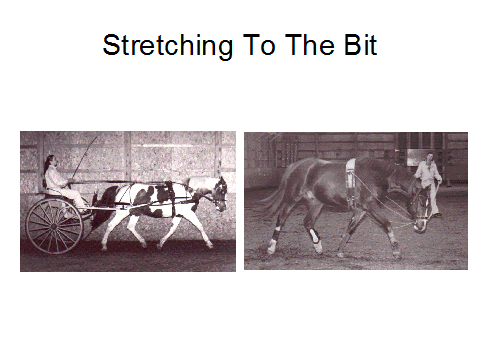
The reason this is not dangerous is that we first train the horse to do this during ground driving, and because he stretches and relaxes his spine which in turn relaxes his mind, he actually controls himself. A tense horse is constantly producing adrenaline which stimulates the flight reflex. A relaxed horse feels safe in his surroundings and does not think of flight. His mind will stay clearer and his reactions will be a lot more thought through should he become startled. Also, when he is working toward the bit, all his energy is really contained by the bit, so if something does startle him he is in direct contact with the driver, his energy is contained between his rear end and the bit, and the driver can quickly adjust rein length or whatever is necessary to keep the horse under control and restore relaxation. And of course, we work the horse in a safe surrounding so even if he would take off for some reason, like snow sliding off the roof of an indoor, he can't go far and can be brought back under control quickly.


Look at it as if you where at his head leading him. It is about the same principle. When you are at his head, you are holding the bit, and he submits to this control, and follows you; when he stretches to the bit he is holding it (and you do too, at the other end of the reins), so it has the same effect for him.
This very effect also enables precise steering. As the horse keeps carrying the bit out in front of himself, he can follow the slightest directional indications of the driver. It is as if someone would keep leading him along by his nose.
Another benefit of this forward action of the bit is that when you really need to stop your horse quickly for whatever reason, the backward restriction that you apply in this case by taking back with both reins firmly, has a lot greater effect. As an aid, it will only come into use on such occasions, and the horse will be a lot more responsive to firm backward pressure, as the usual light forward contact will not have dulled his nerves and reactions.
Choice of bit
What logically follows out of the above is that the choice of bit is extremely important.
Lever action is very counterproductive, we need to know exactly how what we do affects the horse, and we want to make sure that the lightest possible amount of bit is applied to get the required result. What may feel light to us on a lever bit, may actually be a severe aid to the horse.

Aside of that, we need to laterally supple the horse at all times, this is what will keep him from leaning on the bit, avoiding it or hiding behind the bit. If one would use a bit with lever action for that the horse would constantly get pinched on one side of his mouth and then the other. Besides, lever action always has restricting function.
Needless to say that none of the above would further comfort and relaxation.
What we need is direct and constant contact with the horse, and we need to be able to feel both sides of his mouth at all times. The best way to achieve this is with a double jointed snaffle. It conforms well to his mouth and enables us to do all the “talking” we have to do, back and forth, to keep up the communication.
There are lots of different double jointed mouth pieces available, and many of them are not comfortable either due to the size of the joints, or the length or shape of the middle piece.
The best bits are those that have very small joints and a fairly short, smooth or even egg shaped center piece. They affect the roof of the mouth the least if at all, and lie comfortably on the tongue. They should also not be too thick or too thin. Somewhere in the range of one's ring finger, unless you have very thick or thin fingers.
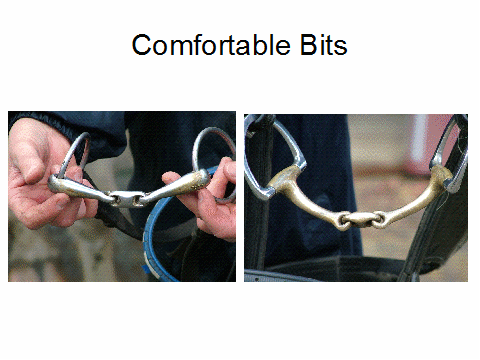

Only direct bit contact conveys precise steering, as soon as lever action is involved the steering is always combined with other pressures which do nothing to help the horse. The only thing they do is make him tense as he is trying to avoid pain, and thus his steering will be a lot less precise.
I want to emphasize it again, like I have so often in the past: lever action is acceptable for straight forward control like driving on roads or trails, and after the horse's mouth has been fully prepared on a snaffle bit. It is never to be used on a young and uneducated mouth, and it is not a tool to teach a horse longitudinal bend, lateral suppleness or steering. Just because a lot of people do it does not make it right for the horse. So if we want to train a horse to be good in classes and events that require a lot of turning, lever action makes no sense in my view. And if we want a pleasure horse to be truly relaxed and comfortable, and thus safe, it does not make sense either.
If for whatever reason more control is needed in events that require lots of turning, the least amount of lever action should be used, the bit should be as comfortable as possible, and the horse should be well prepared for it.
Allowing the time it takes
It may take quite a bit longer to train a horse the relaxed way with a mild bit, and it does require more skill from the driver, but in every aspect it will be well worth it.
Again, horses do not mature mentally until about the age of 8, so why would we overload a young mind with extreme challenges if there is a better way. I do realize that impatience is one of our foremost human traits, and in general horses at the age of 4 or 5 are expected to cope with all the physical and mental stresses that go along with competition, but I also feel that if people know exactly what they are asking of a horse they will reconsider. I used to be very ignorant and very impatient, and I am very ashamed today what I did to horses in the past. I just did not think about it and did not know better. Today, we have so much information at our finger tips with the world wide web, so it has become a whole lot easier to obtain information from lots of different sources.
How to establish correct bit contact
It really is quite hard to explain with words, especially as every horse has its very own needs and requirements, but I will do my best.
A lot depends on neck conformation, body conformation, state of training, temperament and surroundings. And of course on the health and soundness of the animal.
A thick throat latch needs different consideration than a thin one, a ewe type neck will be much different to deal with than a high set on neck, a rump high horse will have a very different balance from an uphill horse etc..It matters what experience, if any, the horse had already with the bit, what his basic personality is, if he likes to please or if he does not want to listen to anything the teacher suggests, and if the surrounding is either distracting of comforting.
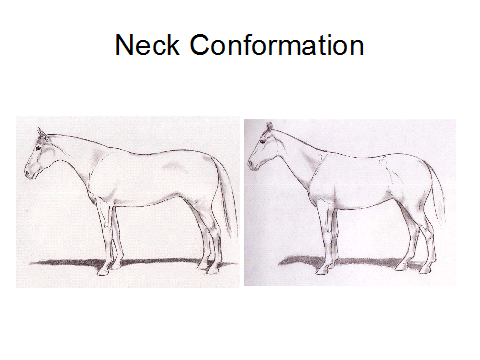
Especially important is that his teeth have been attended to and that there is no joint or muscular pain anywhere in his body.
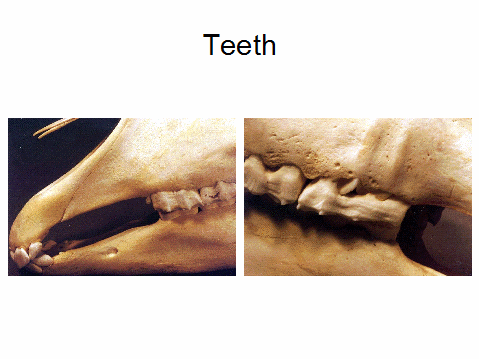
In my book I explain quite a bit about the above so I will have to refer you to that as I only have limited time here.
Below, I will discuss a relatively normal situation.
What do I mean by correct contact?
When talking about correct and beneficial rein contact between the horse and the driver, one means the constant connection between the horse's mouth and the driver's hands, where neither is pulling on the other, where each constantly listens to the other, and where the driver is constantly trying to make the horse as comfortable as possible. It is sort of like a continuous circle of energy.

It is a place where both feel connected with each other, and both are perfectly comfortable and at ease.
Both feel each other, constantly communicate with each other and accommodate each other.
The quality and consistency of the contact that the driver should be striving for I like to compare to a seeing person(the driver) guiding a blind person (the horse).
The horse may not be blind but we want the same responses from him. We want him to totally concentrate on the bit, on the connection and totally trust it for support and guidance, at all times.
Interrupting contact, changing its consistency a lot, not being thoughtful of the “person” on the other end of the reins, will quickly ruin trust and comfort.
Good contact is elastic, as light as possible, always allowing, not hindering, loving and compassionate. It conveys confidence from the driver and instills it in the horse.
In return, the horse will gladly accept his end of the deal which is like a handshake, a willing and trusting “hold” of the bit. As mentioned earlier, he takes it forward with him to a place where he can be in relaxed balance and mental and physical comfort.
When the contact is right, it feels really good, and it gives the driver the feeling that he can now fully relax and there is no need to worry about anything, like the horse drives himself. It is a very liberating feeling. And I am sure the horse feels the same.
How to create this contact
There are four basic rules I want to mention first:
*The only reason we take back on the rein is so that we have something to give.
*The basic idea of this connection is that the horse establishes it and we aid him in doing it.
*The basic effect of the reins is always forward and allowing, even in down transitions.
*The reins really belong to the horse, we are merely there on the other end to keep the slack out of them and to aid the horse in making the right decisions.
Exactly what creates and maintains this contact? A certain amount of pressure on both ends of the reins. I am talking ounces here, the fewer the better. But if any side gives too much, contact will be interrupted, at least momentarily. If either side pulls too much there is no longer mutual freedom, connectedness and acceptance, instead the horse feels restricted and the contact is rigid.
How does one teach that?
a) at a standstill
If the horse is totally new to bit contact, one can teach him to yield to bit pressure at a standstill by taking the slack out of one rein at a time and holding it into the direction of the rein rings on the saddle. This is very important, as we want to teach the horse to respond to pressure by applying first some counter pressure and then yield to it. And counter pressure can only be applied in the opposite direction of where the pressure is coming from. Since we want for the horse to learn to reach forward downward with his head and neck our rein pressure has to come from upward backward. We do NOT want the pressure coming from somewhere at his side, this would only teach him to be pulled together by the bit.
Then, one can vibrate the rein lightly until the horse yields just a little in his poll and jaw. Usually the horse will first respond by putting a lot of pressure against the bit and look for all kinds of possible evasions. As soon as he starts softening his pressure, without totally interrupting it, he needs to be rewarded with a softening of the connection, or at first, a total give on part of the teacher if the horse is very sensitive.
b) with the help of side reins
Another way of introducing bit contact is with help of the sliding side reins as outlined in my book. This can be started while ground driving the horse from the halter while wearing a bit. I prefer this way as it can be done during motion, and the horse can make up his own rules and timing about how to deal with contact and pressure. It is always preferable to introduce rein aids during movement as at a halt they very quickly turn into a backward aid. While in forward motion, the momentum of the movement much easier overcomes the initial backward nature of the bit.
While the sliding side reins also still have the drawback of not always allowing full freedom of the neck, they are still very preferable to any other type of side rein, and when the handler is not very skilled at first, they are a very good crutch to help out both, the horse and the teacher.
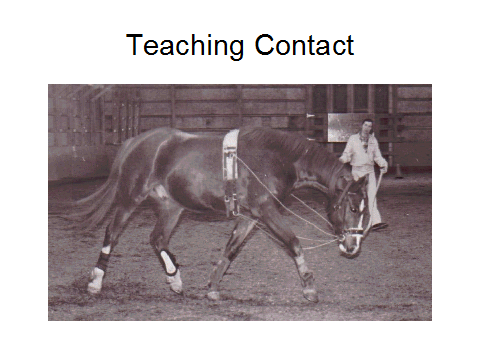
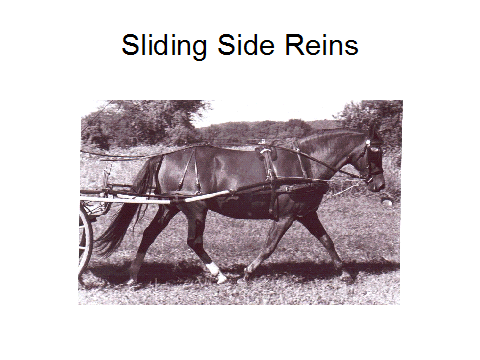
The best way is to not having to use any auxiliary reins. But before I got good at it the side reins made life a lot easier for me and the horses I started.
c) starting with ground driving
When I start with the reins directly from behind, the horse needs at first to ground drive perfectly from the halter, with the reins through the rein rings on top of the surcingle or saddle.
Then, for the first time, when I hook the reins to the bit, I start with guiding them again through the side rings of the surcingle (or the shaft tugs on the harness) until the horse gets used to the contact on his mouth. As soon as I feel that the horse understands that he still can move ahead straight, I rearrange the reins to the top rings. As mentioned before, we want the horse to learn to stretch his neck and head forward downward, not suck it back to his chest.
I will start by taking the slack out of both reins, just so I can feel the mouth on both sides and start moving the bit a little from one side to the other, sort of like jiggling it in the mouth or like massaging the mouth. After a few seconds of this, I will hold the hands still or almost still and ever so slowly and gently reach forward with both hands to encourage the horse to stretch forward. Depending on whether the horse takes the bit forward, this may be very little or quite a few inches. A lot of different responses may come forth from the horse. he may ignore all this, he may try to rip the reins out of my hands, he may lean on the bit, he may hide behind it or he may stick up his head in the air.
He may also take the bit forward downward a little and soften his poll and jaw a bit. Needless to say this is the response I am looking for.
I reward this response by being quite passive until he stops doing the right thing. If he did not offer the right thing to begin with, I just keep encouraging in the above way until he figures out what is best for him. Important is to never interrupt the connection, to not show the horse loop holes where there might be no rein contact at all. For this, the hands need to follow the horse everywhere his head is moving to.
The closer the horse gets to do the right thing the lighter the contact becomes, the more he tries to evade the more restricting it becomes. But it is very important to keep this restriction ever so brief and always offer the horse the way out again by jiggling the bit again and reaching a little forward. Otherwise he may get himself stuck in a place where there is no way out for him.
So what I am looking for in essence is that the horse takes the bit from me forward, and if he no longer does this I will put a little pressure onto the bit and play with it in his mouth, and when I feel the slightest inclination of him to take the bit and/or soften a jaw or his poll, I allow him all the rein again he needs/wants to be comfortable.
So it really is sort of a game: here, horse, the bit is all yours as long as you take it forward downward, but also give a little to it. If you stop taking it, I will have to take it back, so are you sure you would not rather keep it yourself?

Horses figure this out quite quickly, esp. if the teacher is skilled enough to maintain a contact throughout and always allows the reins to act forward.
And I think it becomes now very clear why curb action or a severe type of bit would be most counterproductive for this process.
Frequency of rein aids
Horses will always have to be reminded to do the right thing, even if ever so lightly. Seldom they will do all the right things for more than a few steps in a row, so we always have to be vigilant and supportive to help them back to the right place. This becomes esp. important in an arena with all the turns to be negotiated. Every new turn needs to be prepared and rebalanced, every new direction or movement needs assisting.
The more comfortable, balanced and wise the horse becomes about all this, the less the driver has to do, and often it will be just the slightest movement on the reins, totally invisible to a bystander, that will tell the horse to do a lot of things at the same time like, for example: I would like you to round up your top line a bit more, I would like you to put a bit more energy into your stride, I would like you to go onto a circle now and bend softly and evenly, and I would like you to keep your attention with me and not look what is going on over there.
This is an enormous amount of information that the horse has to deduce from some tiny rein movements, but when he is relaxed, comfortable and willing, and he has been taught with patience and consistency, this is no problem for him.
I could continue to discuss this subject for a long time, and I am sure what I covered left a lot of questions in your mind as it is such a complex subject with so many variables, but I hope I was able to at least put some good thoughts into your mind. Just one last word:
Always consider who is on the other end of your reins
In the pursuit of teaching the horse it can be very easy to forget exactly who is at the other end of our reins. It really is just a horse, not some supernatural being who is perfect all the time. Just like we are only human, with all our faults, and our human ego that so quickly gets in the way. We want our way and we want to look good as a trainer, and we often tend to lose sight that a horse also has lots of limitations.
What always needs to be foremost in our mind is that horses are complex personalities with very much the same feelings we have, and that not considering their point of view at all times is just like treating a good friend in a bad way. They have good and bad days just like we do, and if they don't do their best for us on a given day they always have a very good reason. They don't do anything on purpose, just to annoy us or make us look bad. It is up to us to be forgiving and understanding, and to figure out what the problem might be.